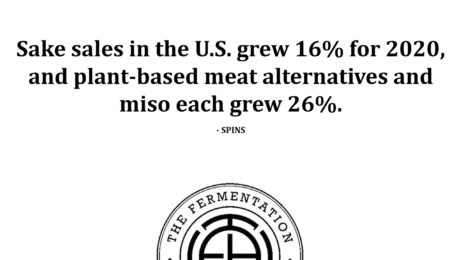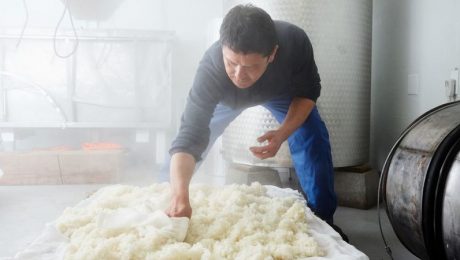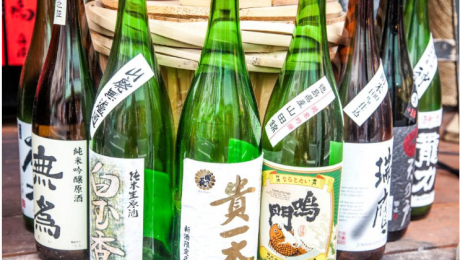The World of Fermented Foods
In the latest issue of Popular Science, a creative infographic illustrates “the wonderful world of fermented foods on one delicious chart.” It represents “a sampling of the treats our species brines, brews, cures, and cultures around the world,” and is particularly interesting as it shows mainstream media catching on to fermentation’s renaissance. Fermentation fit with the issue’s theme of transformation in the wake of the pandemic.
Read more (Popular Science)
- Published in Food & Flavor
Sake, Miso & Plant-Based Meat Sales Grow
Sake sales in the U.S. grew 16% for 2020, and plant-based meat alternatives and miso each grew 26%. – SPINS
- Published in Business, Food & Flavor
Retail Sales Trends for Fermented Food and Beverage
Kimchi, fermented sauces and tempeh are driving growth in the fermented food and beverage category, a $9.2 billion industry that’s grown 4% in the last year.
“We’re excited about the growth potential for fermented food. While fermented food represents about 1.4% of the market today, there are segments that are tracking well above the growth of food and beverage [overall] that are poised for disruption in the future,” says Perteet Spencer, vice president of strategic solutions at SPINS. Spencer shared this information in a recent webinar hosted by The Fermentation Association. “There’s a ton of opportunity to scale and increase the footprint of these products.”
SPINS spent weeks working with TFA to define the fermentation industry’s sales, drilling into 10 fermented product categories and 57 product types. Wine, beer and cheese sales were excluded from the data — those categories are very large, and would obscure trends in smaller categories. (All three are also well-represented by other organizations.)
Pickles and fermented vegetables “is a space that’s seen [a] pretty explosive uptick in growth over the past year,” Spencer says. Every segment is growing — kimchi, sauerkraut, beets, carrots, green beans, sliced and speared pickles and all other vegetables — with pickles the largest, nearly 60% of the category.
The biggest growth, though, is coming from products other than pickled cucumbers. Kimchi is at the center of numerous consumer retail trends. Consumers are purchasing healthier food made with fewer ingredients, and they want food with international flavors. Kimchi makes up only 7% of the category, but sales are increasing at an explosive 90% growth rate.
More people are experimenting with fermenting while they’re at home during the coronavirus pandemic, but these kitchen DIYers do not appear to be detracting from sales.
“The more people make fermented foods, they appreciate what’s available in the store that maybe didn’t exist five or 10 years ago,” notes Alex Lewin, author and TFA advisory board member who moderated the webinar. “Anyone who has made kimchi knows it takes a lot, it makes a big mess, you get red pepper powder stuck under your fingernails and onion in your eyes. I can make kimchi (at home), and then once I’ve made kimchi, I’m like ‘Ok, maybe next time I’ll buy it.’”
Fermented sauces are also growing, up 24% in 2020. The largest segment in sauces is, of course, soy sauce, almost 85% of the category. But gochujang, less than 2% of the category, is increasing at over a 56% growth rate.
Versatility is helping sauces, pickles and fermented vegetables, Spencer says. Any food product with multiple uses is selling well. The condiments and sauces can be used as a topping on eggs, hamburgers or pizza, or mixed-in a salad, rice dish or soup.
Sake, plant-based meat alternatives and miso had combined annual growth of $75 million in 2020. Sake grew 16%, and both plant-based meat alternatives and miso each grew 26%.
Yogurt and kombucha still dominate the fermented food and beverage market. Yogurt is 81% of the market; if yogurt is removed, kombucha is 51% of the remainder.. Both have experienced slowdowns in sales from their peaks. Kombucha sales have slowed recently, as grab-n-go opportunities have shrunk during the pandemic.
Yogurt giant brands Chobani, Yoplait and Dannon still dominate the category, as do GT Kombucha, Health-Ade and Kevita reign for kombucha.
Spencer notes the 4% growth rate of fermented products overall would be higher without yogurt. It’s a large category that — despite an uptick in 2020 during the pandemic – has been fairly flat in recent years. Core (traditional) yogurt has been growing at a 1.6% rate; Greek yogurt, at about twice that pace. Those two segments account for roughly 80% of the category.
“This is an opportunity for disruption for emerging brands,” Spencer says. “We’re already seeing some of the legacy segments start to get disrupted by new innovation, so I’m excited to see the evolution of that innovation and where that goes and kind of what opportunities peek out of that.”
“Overall, we’re seeing historically small segments gaining traction in the marketplace,” Spencer adds. “The pandemic has brought a renewed consumer focus on the fermented space.”
Though fermented products have an added healthy benefit, customers are looking for delicious flavor first.
“In these fermented categories we covered today, taste first is always really important. I think people are going to these categories for different taste experiences,” Spencer says. “If you can level up with a functional benefit, that’s fantastic, but we have to balance the taste first. If it’s highly functional but doesn’t taste good, it just doesn’t have the same success.”
- Published in Business
Intricacies of Sake Maker’s Craft Featured in LA Times
In wine making, the grape is the critical element. The majority of the wine’s characteristics come from the grape. “But for sake making, it’s a little bit different. It’s more about technique, about people controlling the process,” says Yoshihiro Sako of Den Sake Brewery in California. Sako was featured in the Los Angeles Times Rice does not include natural sugars like grapes, so a sake brewer must add koji (a specialized fungus) to convert the rice’s starch into glucose, which then gets fermented into alcohol. Sako says weather conditions, too, can affect the flavor. His latest batches — made after the recent California rains — taste different than batches made during the change. Sako says it’s a way sake “expresses the locality.”
Read more (Los Angeles Times)
- Published in Food & Flavor
Japanese Sake Sales Surging as More Americans Enjoy the Rice Wine
Sake is sliding from the sushi bar to the dinner table. The Japanese sake industry is exporting more of the popular rice wine to America than ever before. More sake brands are putting English descriptions on their labels, which has surged sales growth. Kristin Breshears, a Certified Sake Professional and distributor for Vine Connections, says most Americans drink sake hot, served in a small ceramic cup along with sushi or dropped in a beer. Breshears, though, says sake is “a really beautiful beverage that should be served chilled and hopefully out of a wine glass so you can smell the aromas.”
Read more (New Orleans Gambit)
- Published in Business
Sake Sommeliers Growing Mainstay in Restaurants
As sake becomes mainstream, more restaurants are hiring sake sommeliers. These sommeliers – who help pair the best sake with a meal – are educating diners about the fermented rice wine beverage. There’s a misconception that sake can only be served with Japanese food, but the wine and sake director of Zuma operations in the U.S. says: “Sake is becoming more than just a beverage for Japanese cuisine and we, as sake sommeliers, are looking to have sake displayed in all aspects of restaurant culture.”
Read more (Forbes)
- Published in Business
- 1
- 2






